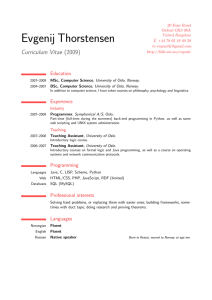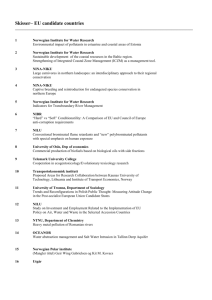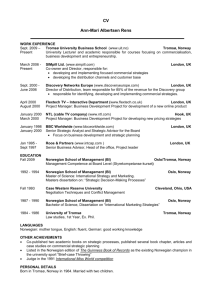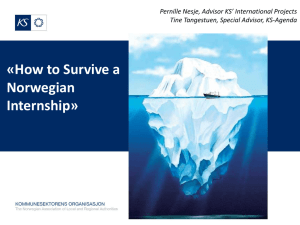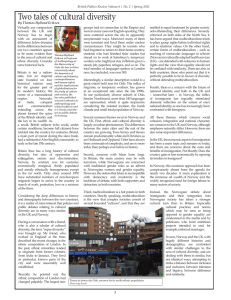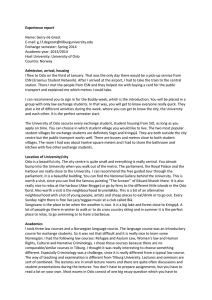at anthropology
advertisement
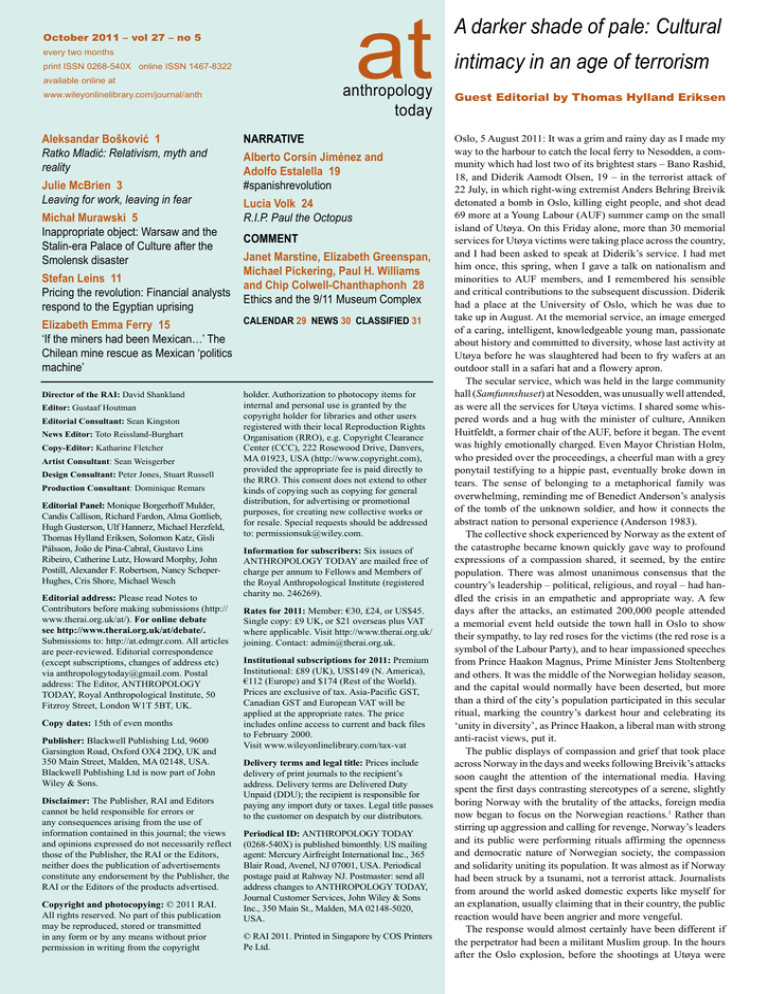
at October 2011 – vol 27 – no 5 every two months print ISSN 0268-540X online ISSN 1467-8322 available online at anthropology today www.wileyonlinelibrary.com/journal/anth Aleksandar Bošković 1 Ratko Mladić: Relativism, myth and reality Julie McBrien 3 Leaving for work, leaving in fear Michał Murawski 5 Inappropriate object: Warsaw and the Stalin-era Palace of Culture after the Smolensk disaster Narrative Alberto Corsín Jiménez and Adolfo Estalella 19 #spanishrevolution Lucia Volk 24 R.I.P. Paul the Octopus Comment Janet Marstine, Elizabeth Greenspan, Michael Pickering, Paul H. Williams Stefan Leins 11 and Chip Colwell-Chanthaphonh 28 Pricing the revolution: Financial analysts Ethics and the 9/11 Museum Complex respond to the Egyptian uprising Calendar 29 News 30 Classified 31 Elizabeth Emma Ferry 15 ‘If the miners had been Mexican…’ The Chilean mine rescue as Mexican ‘politics machine’ Director of the RAI: David Shankland Editor: Gustaaf Houtman Editorial Consultant: Sean Kingston News Editor: Toto Reissland-Burghart Copy-Editor: Katharine Fletcher Artist Consultant: Sean Weisgerber Design Consultant: Peter Jones, Stuart Russell Production Consultant: Dominique Remars Editorial Panel: Monique Borgerhoff Mulder, Candis Callison, Richard Fardon, Alma Gottlieb, Hugh Gusterson, Ulf Hannerz, Michael Herzfeld, Thomas Hylland Eriksen, Solomon Katz, Gísli Pálsson, João de Pina-Cabral, Gustavo Lins Ribeiro, Catherine Lutz, Howard Morphy, John Postill, Alexander F. Robertson, Nancy ScheperHughes, Cris Shore, Michael Wesch Editorial address: Please read Notes to Contributors before making submissions (http:// www.therai.org.uk/at/). For online debate see http://www.therai.org.uk/at/debate/. Submissions to: http://at.edmgr.com. All articles are peer-reviewed. Editorial correspondence (except subscriptions, changes of address etc) via anthropologytoday@gmail.com. Postal address: The Editor, ANTHROPOLOGY TODAY, Royal Anthropological Institute, 50 Fitzroy Street, London W1T 5BT, UK. Copy dates: 15th of even months Publisher: Blackwell Publishing Ltd, 9600 Garsington Road, Oxford OX4 2DQ, UK and 350 Main Street, Malden, MA 02148, USA. Blackwell Publishing Ltd is now part of John Wiley & Sons. Disclaimer: The Publisher, RAI and Editors cannot be held responsible for errors or any consequences arising from the use of information contained in this journal; the views and opinions expressed do not necessarily reflect those of the Publisher, the RAI or the Editors, neither does the publication of advertisements constitute any endorsement by the Publisher, the RAI or the Editors of the products advertised. Copyright and photocopying: © 2011 RAI. All rights reserved. No part of this publication may be reproduced, stored or transmitted in any form or by any means without prior permission in writing from the copyright holder. Authorization to photocopy items for internal and personal use is granted by the copyright holder for libraries and other users registered with their local Reproduction Rights Organisation (RRO), e.g. Copyright Clearance Center (CCC), 222 Rosewood Drive, Danvers, MA 01923, USA (http://www.copyright.com), provided the appropriate fee is paid directly to the RRO. This consent does not extend to other kinds of copying such as copying for general distribution, for advertising or promotional purposes, for creating new collective works or for resale. Special requests should be addressed to: permissionsuk@wiley.com. Information for subscribers: Six issues of ANTHROPOLOGY TODAY are mailed free of charge per annum to Fellows and Members of the Royal Anthropological Institute (registered charity no. 246269). Rates for 2011: Member: €30, £24, or US$45. Single copy: £9 UK, or $21 overseas plus VAT where applicable. Visit http://www.therai.org.uk/ joining. Contact: admin@therai.org.uk. Institutional subscriptions for 2011: Premium Institutional: £89 (UK), US$149 (N. America), €112 (Europe) and $174 (Rest of the World). Prices are exclusive of tax. Asia-Pacific GST, Canadian GST and European VAT will be applied at the appropriate rates. The price includes online access to current and back files to February 2000. Visit www.wileyonlinelibrary.com/tax-vat Delivery terms and legal title: Prices include delivery of print journals to the recipient’s address. Delivery terms are Delivered Duty Unpaid (DDU); the recipient is responsible for paying any import duty or taxes. Legal title passes to the customer on despatch by our distributors. Periodical ID: ANTHROPOLOGY TODAY (0268-540X) is published bimonthly. US mailing agent: Mercury Airfreight International Inc., 365 Blair Road, Avenel, NJ 07001, USA. Periodical postage paid at Rahway NJ. Postmaster: send all address changes to ANTHROPOLOGY TODAY, Journal Customer Services, John Wiley & Sons Inc., 350 Main St., Malden, MA 02148-5020, USA. © RAI 2011. Printed in Singapore by COS Printers Pe Ltd. A darker shade of pale: Cultural intimacy in an age of terrorism Guest Editorial by Thomas Hylland Eriksen Oslo, 5 August 2011: It was a grim and rainy day as I made my way to the harbour to catch the local ferry to Nesodden, a community which had lost two of its brightest stars – Bano Rashid, 18, and Diderik Aamodt Olsen, 19 – in the terrorist attack of 22 July, in which right-wing extremist Anders Behring Breivik detonated a bomb in Oslo, killing eight people, and shot dead 69 more at a Young Labour (AUF) summer camp on the small island of Utøya. On this Friday alone, more than 30 memorial services for Utøya victims were taking place across the country, and I had been asked to speak at Diderik’s service. I had met him once, this spring, when I gave a talk on nationalism and minorities to AUF members, and I remembered his sensible and critical contributions to the subsequent discussion. Diderik had a place at the University of Oslo, which he was due to take up in August. At the memorial service, an image emerged of a caring, intelligent, knowledgeable young man, passionate about history and committed to diversity, whose last activity at Utøya before he was slaughtered had been to fry wafers at an outdoor stall in a safari hat and a flowery apron. The secular service, which was held in the large community hall (Samfunnshuset) at Nesodden, was unusually well attended, as were all the services for Utøya victims. I shared some whispered words and a hug with the minister of culture, Anniken Huitfeldt, a former chair of the AUF, before it began. The event was highly emotionally charged. Even Mayor Christian Holm, who presided over the proceedings, a cheerful man with a grey ponytail testifying to a hippie past, eventually broke down in tears. The sense of belonging to a metaphorical family was overwhelming, reminding me of Benedict Anderson’s analysis of the tomb of the unknown soldier, and how it connects the abstract nation to personal experience (Anderson 1983). The collective shock experienced by Norway as the extent of the catastrophe became known quickly gave way to profound expressions of a compassion shared, it seemed, by the entire population. There was almost unanimous consensus that the country’s leadership – political, religious, and royal – had handled the crisis in an empathetic and appropriate way. A few days after the attacks, an estimated 200,000 people attended a memorial event held outside the town hall in Oslo to show their sympathy, to lay red roses for the victims (the red rose is a symbol of the Labour Party), and to hear impassioned speeches from Prince Haakon Magnus, Prime Minister Jens Stoltenberg and others. It was the middle of the Norwegian holiday season, and the capital would normally have been deserted, but more than a third of the city’s population participated in this secular ritual, marking the country’s darkest hour and celebrating its ‘unity in diversity’, as Prince Haakon, a liberal man with strong anti-racist views, put it. The public displays of compassion and grief that took place across Norway in the days and weeks following Breivik’s attacks soon caught the attention of the international media. Having spent the first days contrasting stereotypes of a serene, slightly boring Norway with the brutality of the attacks, foreign media now began to focus on the Norwegian reactions.1 Rather than stirring up aggression and calling for revenge, Norway’s leaders and its public were performing rituals affirming the openness and democratic nature of Norwegian society, the compassion and solidarity uniting its population. It was almost as if Norway had been struck by a tsunami, not a terrorist attack. Journalists from around the world asked domestic experts like myself for an explanation, usually claiming that in their country, the public reaction would have been angrier and more vengeful. The response would almost certainly have been different if the perpetrator had been a militant Muslim group. In the hours after the Oslo explosion, before the shootings at Utøya were Thomas Hylland Eriksen is Professor of Social Anthropology, University of Oslo. Recent books in English include Engaging anthropology (2006), Globalization: The key concepts (2007) and (co-edited) A world of insecurity (2010). His email is t.h.eriksen@sai.uio.no Fig. 1. Diderik Aamodt Olsen, killed on 22 July. 1. For representative foreign press coverage, see ‘At least 80 dead in Norway shooting’, New York Times, 23 July 2011; ‘La Norvège abandonnera jamais ses valeurs d’ouverture’, Le Figaro, 24 July 2011; ‘Parecía un paisaje de guerra’, El Pais, 23 July 2011; ‘Politiker verurteilen feige TerrorAnschlagen’, Focus Online, 22 July 2011. 2. 90,000 people in Norway belong to a Muslim congregation. The number of residents with a background in a predominantly Muslim country is around 180,000, or 3.5 per cent of the population; in the Greater Oslo region, the proportion is higher. Statistics Norway, www.ssb.no. 3. Among the most influential are JihadWatch, Brussels Journal and Gates of Vienna. Anderson, B. 1983. Imagined communities. London: Verso. Bangstad, S. & M. Bunzl 2010. Anthropologists are talking about Islamophobia and anti-semitism in the new Europe. Ethnos 75(2): 213-228. Bowen, J. 2011. Europeans against multiculturalism. Boston Review July/August. Bunzl, M. 2007. Anti-Semitism and Islamophobia: Hatreds old and new in Europe. Chicago: Prickly Paradigm/ University of Chicago Press. Gingrich, A. 2005. Anthropological analyses of Islamophobia and anti-semitism in Europe. American Ethnologist 32(4): 513-515. Gullestad, M. 2006. Plausible prejudice: Everyday experiences and social images of nation, culture and race. Oslo: Universitetsforlaget. Holmes, D. 2000. Integral Europe: Fast-capitalism, multiculturalism, neofascism. Princeton: Princeton University Press. Witoszek, N. 2011. The origins of the ‘regime of goodness’: Remapping the cultural history of Norway. Oslo: Universitetsforlaget. Ye’Or, B. 2007. Eurabia: The Euro-Arab axis. Madison: Fairleigh Dickinson University Press. 2 known, it quickly became a form of tacit common knowledge that an Islamist terrorist group was responsible. By late afternoon, Muslims2 were already being harassed on the streets of Oslo, and some terrorism experts on television were intimating that the attack bore the hallmarks of an al-Qaeda operation. Norwegian nationalism has several scripts readily available for responding to foreign invaders and enemies. It is far more difficult to make sense culturally of a terrorist who is 100% Made in Norway, and to frame his actions within a known narrative. Since to many Norwegians, Norway signifies inherent goodness (Witoszek 2011), it has been tempting to view Breivik as an isolated madman. Yet it is impossible to deny that he developed his Manichean worldview in an ideological universe shared by many Norwegians (and other Europeans), according to which there is an irreconcilable conflict between the West and Islam. As we try to understand the powerful displays of solidarity after 22 July, it is important to keep in mind the fact that this was a homegrown kind of terrorism. On the face of it, Breivik was an utterly unremarkable man from the leafy western suburbs of Oslo. However, he never completed an education, failed in his business ventures and must have been perceived as something of a failure in his middle-class surroundings. Studies of right-wing extremism and militant identity politics tend to show that recruits often have a background in the lower middle class and a strong sense of injustice and de facto disenfranchisement, usually tinged with conspiratorial leanings (Holmes 2000). Yet, of course, many find themselves in a structurally identical position to Breivik without becoming violent. Whatever Breivik’s personal motivations, his actions remind us of the importance of recognizing the presence of Islamophobic tendencies in Norwegian society. Anthropologists have been writing about European Islamophobia for years (Bangstad & Bunzl 2010; Bowen 2011; Bunzl 2007; Gingrich 2005), but rarely as a security threat from within. Recruitment to contemporary far-right militant circles follows a very different logic to that of old-fashioned extremist movements. This is partly why the Norwegian Police Security Service had not hitherto viewed the new extreme right as a security threat. These militants do not have organizations and membership lists, indeed they do not even share a coherent ideology. What they have in common is a conviction that their government is betraying the nation by allowing Muslims to settle in Norway, since, in their view, Islam is incompatible with democracy and modernity. The logical implication of this view, propagated via a forest of websites, domestic and European,3 is that the blight on Europe it identifies cannot be set right through democratic means. There are degrees and nuances in the Islamophobic discourse. While it is likely that only a hardcore minority believes the paranoid conspiracy theories that circulate on such sites, high-ranking members of Norway’s second-largest party, Fremskrittspartiet (the Progress Party), have in recent years repeatedly spoken in generalizing and pejorative terms about Muslims. The party’s influential chairman, Carl I. Hagen, has declared that ‘not all Muslims are terrorists, but all terrorists are Muslims’ (Aftenposten, 26 August 2005). The current party chair, Siv Jensen, spoke last year about ‘covert Islamization’ (snikislamisering); when asked, she was unable to offer a single example of this hidden tendency. Other leading members of the party, which won 22.9 per cent of the vote in the 2009 general election, have expressed similar views. One runs a Facebook group for people who refuse to take taxis with Muslim drivers. Some of those who actively pursue an anti-Muslim agenda in Norwegian public life see themselves as disillusioned social democrats, others as feminists or defenders of the legacy of the European Enlightenment, with its emphasis on individual rights. Islamophobia cannot, therefore, be identified with a particular social group or political party; to some extent, it permeates the fabric of society. The very ordinariness of the new right wing signals that it cannot be written off as marginal. The view that Islam is incom- patible with democracy, and that Norway has made a serious mistake in allowing Muslims to settle in the country, is propagated in election campaigns, online debates, op-ed articles and books on contemporary politics. In his ‘manifesto’, largely a cutand-paste job, Breivik includes 39 articles written by his intellectual hero, a blogger known as Fjordman, who has been active on Islamophobic websites for years. Fjordman believes in conspiracy theories of the ‘Eurabia’ kind (Ye’Or 2007),4 according to which European governments made secret arrangements with Arab leaders in the 1970s permitting de facto Muslim dominance in Europe in exchange for Gulf oil. Fjordman’s identity has now been revealed. He is Peder Jensen from Ålesund. The most striking thing about Fjordman, one of the most vitriolic critics of ‘Islamization’, a man who talks incessantly and obsessively about inevitable civil war and conflict, quisling governments and Muslim conspiracies – is his bland ordinariness. A curly-haired man in his mid thirties, with a leather bag slung over his shoulder, Jensen could easily pass for a postdoc in an anthropology department. Which is not very far from the truth, as he completed his MA degree in Media and Communication in 2004, writing his dissertation on bloggers in Iran. The precise ways in which a generalized yearning for ‘purity’, a recurrent trope in European nationalisms, came to be distilled in paranoid conspiracy theories about Western governments and Muslim plots will be the subject of inquiry for years. What is clear, however, is that Breivik and Fjordman are not alone in harbouring such views. The extent to which their particular brand of Islamophobia and right-wing nationalism should be understood in terms of the racial supremacism that forms a dark undercurrent in Norwegian nationalism (Gullestad 2006) must be a special focus of this inquiry. Yet in the weeks following the terrorist attacks, an opposite image of the Norwegian nation emerged. The power elite – clergy, royalty, government – wept and grieved with the rest of the country. Thousands gathered in public spaces across Norway to lay flowers and show their solidarity with the dead and bereaved. At this moment, there was no talk of ‘us and them’. The attacks may, paradoxically, have paved the way for a less ethno-cultural, more civic-territorial concept of the Norwegian nation. Like everybody else, immigrants mourned the deaths of their metaphoric family members. Moreover, several of the Utøya victims had a minority background. Active in the youth wing of the senior party in government, they had chosen to engage themselves in a mainstream political party. They were, undeniably, fully paid-up members of Norwegian society. The predominance of civic rituals of compassion and solidarity can partly be explained by the absence from Norway of a strong cultural narrative denouncing ‘traitors from within’, by the terrorist’s mainstream background, and by Norway’s self-understanding as an empire of goodness. However, scale is also a crucial factor. The country’s small population (five million), combined with modest class differences and a high degree of informality, makes the work of moulding the population into a metaphorical family easier in Norway than it would have been in a larger and more heterogeneous society. Norway is, after all, a country where the prime minister has been known to introduce himselves at parties with ‘Hi, my name is Jens, I’m Camilla’s brother.’ At the ceremony in the Nesodden community hall, attended by many hundreds of mourners, a secular hymn based on a poem by the socialist poet Nordahl Grieg was sung. Written in 1936, when fascism was on the rise in Europe, the poem, “Til ungdommen” (“To the youth”), contrasts the power of military force with the power of humanist values. It was sung at the ceremony by a young black woman with an African name. Perhaps, one cannot help thinking, the catastrophe of 22 July will retrospectively be seen as the founding moment of the new Norway, a country in Diderik Aamodt Olsen’s spirit, a country of which he would have been proud. l ANTHROPOLOGY TODAY Vol 27 No 5, October 2011


